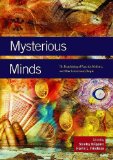Dr. Katherine Ramsland: Neurobiology and the Psychic
Dr. Katherine Ramsland has published 37 books, 16 short stories, and over 900 articles. She is professor of forensic psychology and criminal justice at DeSales University, and her latest books are Inside the Minds of Sexual Predators and The Forensic Psychology of Criminal Minds.
Neurobiology and the Psychic
On April 9, 2005, the Appalachian News-Express reported that a psychic had located a missing person in a surprising way. Lynn Ann Maker, a “psychometrist” and “psychic detective,” was contacted by the family of Greg Wallace, who’d gone missing while commuting to his job in March. His car was found near a pond, with the keys inside and the hood raised. The police had searched the pond but found nothing. The man’s whereabouts remained unknown and the family was frantic.
At her own expense, Maker visited the place from which Wallace had disappeared. She held one of his shirts and said that she sensed he was submerged. Just then, she “felt the need” to go into the pond. After taking a few steps, she stopped. A body floated to the surface. She recognized the deceased from photos as Wallace and called 911. The Georgia Bureau of Identification affirmed that the dead man was Wallace and said that Maker’s “find” was a coincidence.
She said to reporters that she did not know how Wallace had died. It’s a common misperception, she added, that psychics know everything. She just takes whatever she gets. “It comes to me and I relay it.”
Other psychics have made similar comments, and one person who claims to possess second sight (and did not wish to be named) offered a description:
“From what I’ve experienced the images are quite often too fleeting. Sometimes I will get an image that is strong and sometimes only a hint of what happened. It’s like when you first walk into a building with an unusual smell and as your body becomes attuned to the smell you can no longer smell it. It requires walking away, then coming back to revive the senses. I find this is the same with me when I get to an area where the senses start to work over something that happened… I have to let go and try again sometimes. It’s not always the case that a person gets anything, either, if the aura energy left over isn’t strong enough.
“For instance, a person may be rendered unconscious before the stabbing and cutting began, therefore lessening the impact of what the aura energy could have told a person. The greater the fear and pain experienced while conscious, the greater the amounts of aura energy left behind. If a [psychic] person was to stand or sit on the spot where someone was actually murdered, they might see some fleeting images of faces but more likely the battle itself. When one knows they are dying, they are more intent on the survival aspect and not the person’s face who is killing them.”
While psychic “flashes” may be helpful in some cases, there is no way to determine in the midst of an investigation if one will be fruitful, so investigators are justifiably cautious. (In fact, aside from this “find” for Maker, she had logged no other success stories on her now-defunct website.) Police who have used psychics know there are both hits and misses, with more of the latter, generally, than the former. Still, if abilities like Maker’s are genuine, one would think that today’s precision brain research could prove it. That is, as she stepped into the water in response to her impression, some measurable brain process should have activated.
Psychologists Stanley Krippner and Harris Friedman apparently think this idea is worth checking out. They have edited an anthology, Mysterious Minds, which is dedicated to neurobiological studies of psychics, mediums, and “other extraordinary people.” Krippner is professor of psychology at Saybrook University, and among his interests are the dreaming brain, identifying deception in paranormal investigations, hypnosis and healing, and shamanism. Morris Friedman, a research psychologist, has focused on cognitive impairment and behavioral neurology. As a team with solid credentials, they’re open to anomalous experiences while also alert to fraud, spurious claims, and the need to corroborate statements with evidence.
Among the book’s topics are laboratory evidence for ESP, electrical activity in the brains of “sensitives” during a trance, and psychokinesis. Some of the articles require scientific or medical background to fully understand, but the editors provide a readable introduction and postscript. This is serious stuff, not for fans of mindless entertainment shows who believe everything they see or hear about ghost hunters and mediums. The authors take nothing at face value. Instead, they seek to verify subjective reports of psychic impressions with brain research methods (although they admit that the correlation of EEG and fMRI readings with psychic experiences does not necessarily prove anything).
The first article presents an overview of the research to date in psi phenomena, and several others confirm that brain activity associated with ESP and similar experiences appears to be centered in the temporal and occipital lobes. Some researchers believe we need “more adventurous” designs, since current research results are only “suggestive” at best. In fact, little in this book lives up to the enticing title, unless you take the advice of one pair of scientists who advocate the use of psychedelic drugs. The brain’s own DMT chemical certainly offers possibilities, as people who’ve taken laboratory samples of it have reported seeing angels, demons, aliens, and dead people. This may open some interesting doors.
Unfortunately, no one in this book discussed the intriguing experiment in Switzerland in 2006, in which an area stimulated in the brain of a female patient induced the sensation of a ghost standing near her. “His” position mirrored hers and she was able to discern his intentions. This was the sort of research I’d hoped for in this volume, but it leaned instead toward mapping brain correlates of psychic impressions. Yet I was glad to see that among the “extraordinary people” were Brazilian healers with their remarkable trances, and the chapter devoted to them is quite provocative. However, my hope for revelations was dashed.
To the editors’ credit, they include an article that covers the areas and methodologies that researchers of paranormal phenomena must address if they expect to mainstream science to take them seriously. However, that same article pretty much demonstrated that psychic research in a scientific venue has a long way to go.
In the end, this compendium offers little to investigators who want to scientifically affirm the use of a psychic. At best, it’s just a start, so the nature of what psychics usually provide will continue to be controversial. Even the case of Maker finding Wallace had less fanfare than one might expect. Skeptics dismissed it as logic and luck, while psi believers claimed it as an example of psychic success. If it is truly the latter, you’d think it would have garnered headlines far beyond the Appalachian News-Express. As the researchers in Mysterious Minds admit, proof just isn’t there yet.





I really enjoyed Neurobiology and the Psychic. Also, your other writings. I just found your article about me. Other wise I would of wrote you earlier. I look forward to more of your work. God Bless!
Good luck, Lee. You will especially appreciate your new home come, say, January…
You forgot the “I’m fixin’ to”
Good luck, and enjoy the new surroundings.
Have a great trip down-it’ll just keep getting warmer and warmer! 🙂
I am so thrilled for the two of you – after living in Georgia for 30 years there’s a whole lot of stuff I miss. Now you can enjoy them for me 🙂
Howdy Lee.
Tell Denene Dave says ‘Hey.’
And lotsa’ luck to you and yours!
Well, the ring tone on my cell phone is the whistling theme to the Andy Griffith Show.
It seems fitting somehow that you’ll be living near the real Mayberry. Some things were meant to be!